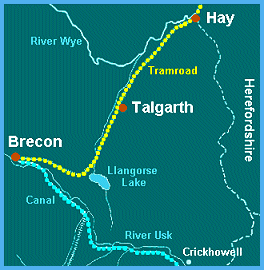These tramways were an early form of railway, but with horses pulling short trains consisting of small trucks called trams. One of these tramways was opened between Brecon and Hay in 1816 and was later extended into Herefordshire. (See map on the right).
The tramroad connected with The Brecknock & Abergavenny Canal (shown in the blue dotted line). Coal and lime coming up the canal to Brecon could be loaded onto trams and taken along the tramroad to smaller rural communities, and farm produce brought back along the same track.

|
The
tramroad from Brecon to Hay
|
 could
pull more weight on a smooth and fairly level set of rails than it could
over a steep and bumpy road.
could
pull more weight on a smooth and fairly level set of rails than it could
over a steep and bumpy road.